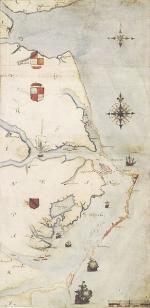Tree Rings and Coral Reefs
 Image Credit: Wikipedia
Image Credit: Wikipedia
The Lost Colony
Analyses of tree ring growth data also help scientists reconstruct past drought records. In the 1580s, the first English colony, known as the Roanoke colony or the Lost Colony, disappeared from the North Carolina coast. Persistent drought in late 16th and early 17th centuries may have contributed to colonists' disappearance.
Tree rings and coral reefs indicate past growth rates. As a tree grows, it produces a layer of wood beneath the bark. In the spring growing season, the plant tissue produces larger, thin-walled wood cells with a light appearance; and in the summer, the plant tissue produces thick-walled wood cells with a darker appearance. Each tree ring indicates a year of growth. Trees tend to grow faster in warm and moist years.
Some ancient bristlecone pines that grow in the Great Basin region of western North America are approximately 5,000 years old. Generally, tree rings date back 500 to 700 years. In New Zealand, however, the long-lived Kauri pine can help scientists date back as far as 50,000 years.

Scientists obtain coral cores from the largest known coral head on Earth at Ofu Island November 2011.
Image Credit: Dr. Rob Dunbar.
Many species of corals also have growth rings similar to those of trees. Scientists can extract cores from coral, and the coral growth rings can be used to reconstruct past climate in the tropical and subtropical regions. Corals grow faster in warmer waters.
